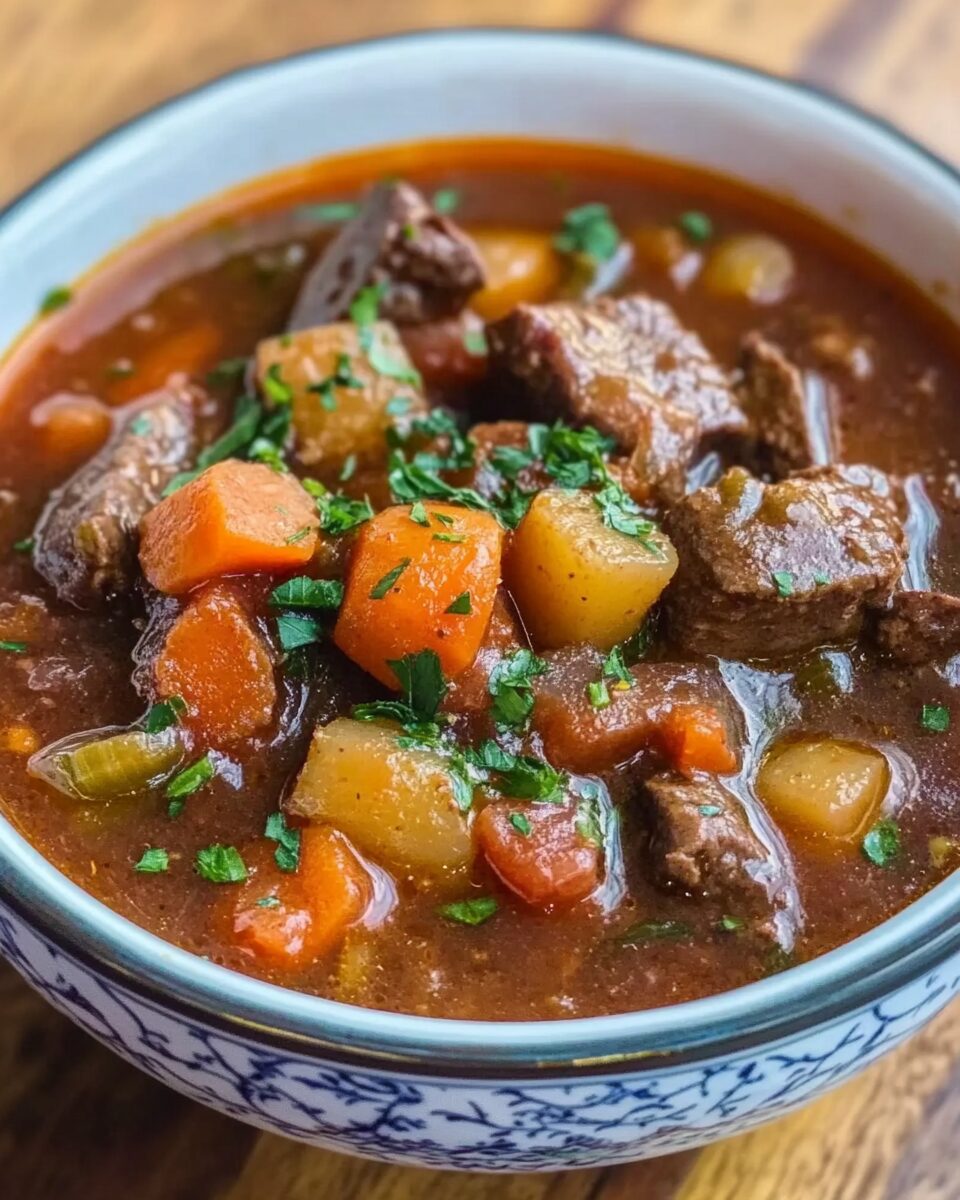There’s something deeply comforting about a bowl of slow-cooked beef stew. The tender chunks of beef, soaked in a rich, flavorful broth, create the ultimate winter comfort dish. This meal is packed with wholesome root vegetables, aromatic herbs, and a touch of red wine, bringing out deep, complex flavors.
This dish is perfect for family dinners, meal prep, or even entertaining guests on a chilly night. Serve it with a side of warm, crusty bread to soak up the flavorful broth, and you have a meal that’s both nourishing and incredibly satisfying. Whether you make it in a Dutch oven or a slow cooker, this stew is a staple recipe that you’ll keep coming back to.
Full Recipe:
Ingredients:
- 2 lbs beef chuck, cut into 1-inch cubes
- 2 tablespoons olive oil
- 1 large onion, chopped
- 3 cloves garlic, minced
- 3 medium carrots, sliced
- 3 medium potatoes, diced
- 2 celery stalks, chopped
- 4 cups beef broth
- 1 cup red wine (optional)
- 2 tablespoons tomato paste
- 1 teaspoon Worcestershire sauce
- 1 teaspoon dried thyme
- 1 teaspoon dried rosemary
- 1 bay leaf
- 1 teaspoon salt, or to taste
- ½ teaspoon black pepper
- 2 tablespoons all-purpose flour
- 2 tablespoons butter
- Fresh parsley for garnish
Directions:
- Sear the Beef: Heat 1 tablespoon of olive oil in a large pot over medium-high heat. Toss the beef cubes with salt, pepper, and flour, then sear until browned on all sides. Remove from the pot and set aside.
- Sauté the Aromatics: In the same pot, add the remaining olive oil. Sauté onions and garlic until fragrant and softened, about 2 minutes.
- Deglaze the Pot: Pour in red wine (if using) and scrape up any browned bits from the bottom of the pot. Allow it to simmer for 2 minutes.
- Build the Stew Base: Add tomato paste, Worcestershire sauce, beef broth, thyme, rosemary, and bay leaf. Stir well to combine.
- Simmer with Vegetables: Return the beef to the pot along with carrots, potatoes, and celery. Bring to a boil, then reduce heat and let it simmer for 1.5 to 2 hours until the beef is tender.
- Thicken the Stew: In a small pan, melt butter and stir in flour to create a roux. Stir the roux into the stew and let it cook for another 5 minutes until thickened.
- Garnish and Serve: Remove bay leaf, adjust seasoning if necessary, and garnish with fresh parsley before serving.
Prep Time: 15 minutes | Cooking Time: 2 hours | Total Time: 2 hours 15 minutes
Kcal: 410 kcal | Servings: 6 servings
Origins & Cultural Significance
Beef stew is a dish with deep historical roots, found in nearly every cuisine worldwide. Its origins date back to ancient times when early civilizations cooked meat with vegetables and liquid over a fire. The concept of slow-cooking tough cuts of beef in liquid to tenderize them has been a technique used for centuries.
In French cuisine, a version of beef stew known as Boeuf Bourguignon is made with red wine, mushrooms, and pearl onions. Meanwhile, in Ireland, Irish Stew features beef (or traditionally lamb), potatoes, and carrots, often simmered with Guinness beer for added richness. Variations of beef stew can be found across Europe, Asia, and the Americas, each with regional ingredients and spices that reflect the local flavors.
Why This Recipe Works
- Tender Beef: Cooking the beef low and slow allows the connective tissues to break down, making the meat incredibly tender and flavorful.
- Rich Flavor: A combination of red wine, Worcestershire sauce, and tomato paste creates a deep umami taste, making the broth incredibly savory and well-balanced.
- Nutritious & Hearty: Packed with root vegetables like carrots, potatoes, and celery, this stew is high in fiber, vitamins, and minerals, making it a wholesome meal.
- Perfect for Make-Ahead & Meal Prep: Beef stew actually tastes better the next day as the flavors continue to develop in the fridge. It’s an ideal recipe to make in bulk and store for future meals.
Ingredient Substitutions & Variations
- Protein Options: If you don’t have beef chuck, try using brisket, short ribs, or even lamb for a different flavor profile.
- Vegetables: You can swap potatoes for sweet potatoes, parsnips, or butternut squash for a slightly different texture and taste.
- Wine Alternative: If you prefer to cook without alcohol, replace the red wine with an equal amount of beef broth mixed with a tablespoon of balsamic vinegar or red wine vinegar for a similar depth of flavor.
- Thicker Stew: If you prefer a thicker consistency, mix 1 tablespoon of cornstarch with 2 tablespoons of water and stir it into the stew during the last 10 minutes of cooking.
- Spices & Herbs: Add a touch of smoked paprika, cumin, or even a pinch of cinnamon for an extra layer of flavor.
Frequently Asked Questions
💬 Can I make this in a slow cooker?
Yes! Brown the beef first, then add all ingredients to the slow cooker and cook on LOW for 6-8 hours or HIGH for 4-5 hours.
💬 Can I use ground beef instead of beef chunks?
Technically yes, but you’ll get a different texture. Ground beef stews cook faster but won’t have the same rich, slow-cooked flavor.
💬 Why is my beef stew meat tough?
If your beef is tough, it likely needs more cooking time. Let it simmer longer to break down the connective tissue and tenderize the meat.
💬 How do I make this stew gluten-free?
Omit the flour and use cornstarch or arrowroot powder as a thickener instead. Also, make sure your Worcestershire sauce is gluten-free.
💬 Can I add mushrooms to the stew?
Absolutely! Sauté mushrooms separately and add them in the last 20 minutes of cooking for a boost of umami flavor.
Cooking Tips for the Best Beef Stew
Choosing the Best Beef for Stew
Tougher cuts of beef with more connective tissue work best because they break down during slow cooking, making the meat juicy and tender. The best options include:
- Beef Chuck – The most popular choice, as it becomes extremely tender when simmered.
- Brisket – Has a richer flavor and holds up well in stews.
- Short Ribs – Adds a deeper beefy flavor and extra richness.
- Bottom Round or Top Round – A leaner option but still works well for slow-cooking.
How to Get Maximum Flavor
- Brown the Beef Well – Searing the meat in batches helps develop deep caramelized flavors. Avoid overcrowding the pan.
- Use Wine or Vinegar – A bit of acidity helps balance the richness of the broth and adds complexity. Red wine or balsamic vinegar are great choices.
- Layer the Ingredients – Start with aromatics (onions, garlic), then add meat and liquids, followed by vegetables to maintain their texture.
- Cook Low and Slow – This allows the flavors to meld together and results in the most tender beef.
Ingredient Swaps & Variations
Want to change things up? Here are some easy modifications:
👉 No Red Wine? Swap it out for extra beef broth and a tablespoon of Worcestershire sauce or balsamic vinegar.
👉 Low-Carb Option? Skip the potatoes and add more low-carb veggies like cauliflower or zucchini.
👉 Thicker Stew? Stir in a cornstarch slurry (1 tablespoon cornstarch mixed with 2 tablespoons water) during the last 10 minutes of cooking.
👉 Spicier Version? Add a pinch of red pepper flakes or cayenne for heat.
👉 Extra Depth of Flavor? Stir in a teaspoon of soy sauce or a splash of fish sauce for a subtle umami boost.
Serving Suggestions
This beef stew is delicious on its own, but here are some great ways to serve it:
🥖 With Crusty Bread – A warm baguette or sourdough bread is perfect for soaking up the rich broth.
🥔 Over Mashed Potatoes – Spoon the stew over creamy mashed potatoes for the ultimate comfort food experience.
🍚 With Rice or Egg Noodles – A great way to turn this into a heartier meal.
🥗 With a Fresh Salad – A light, tangy side salad can help balance out the richness of the stew.
Storage & Reheating Tips
Beef stew tastes even better the next day, making it a great make-ahead meal!
- Refrigeration: Store in an airtight container for up to 4 days.
- Freezing: Cool the stew completely before transferring to a freezer-safe container. Freeze for up to 3 months.
- Reheating: Warm on the stovetop over low heat, stirring occasionally. If needed, add a splash of water or broth to loosen the consistency.
Conclusion
This Hearty Classic Beef Stew is a timeless dish that brings comfort and flavor to every meal. Whether you’re making it for a cozy family dinner, meal prepping for the week, or serving it on a special occasion, it’s a recipe you’ll return to again and again.
Its rich, deep flavors and melt-in-your-mouth beef make it a favorite in many households, and the best part? It’s completely customizable! Try different veggies, seasonings, or serving styles to make it your own.
✨ Enjoy your homemade beef stew and let us know how it turns out! Share your experience in the comments below! ✨

